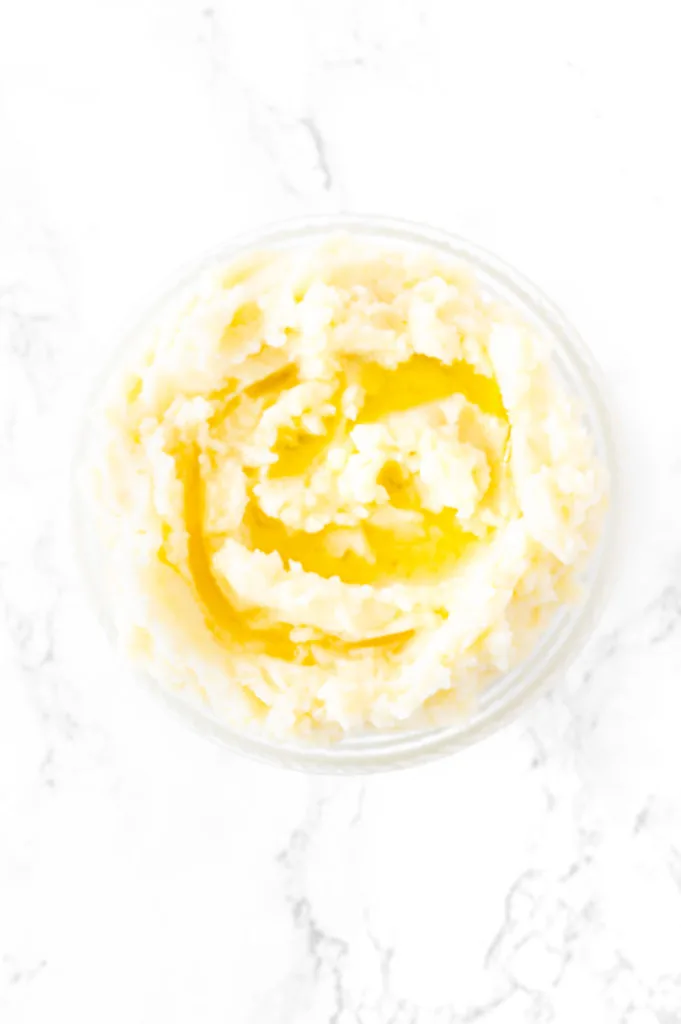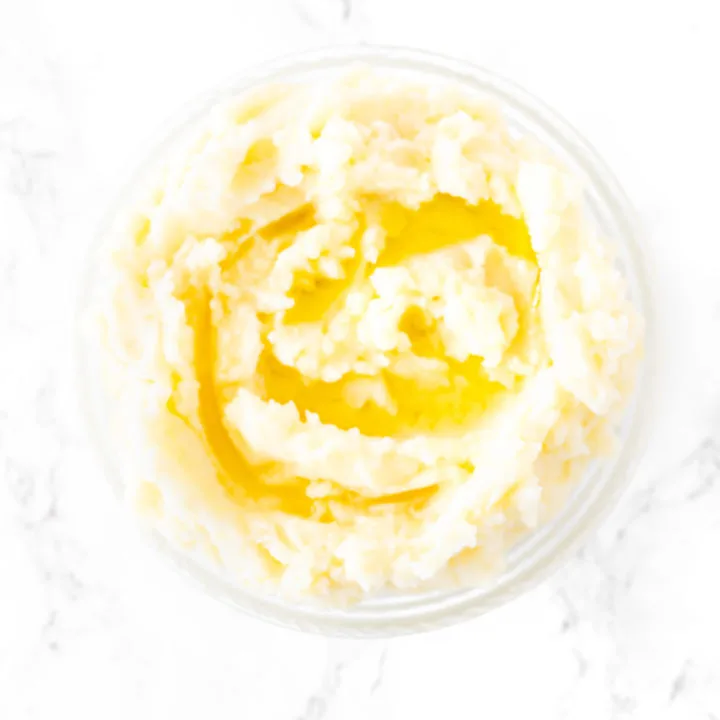These Mashed Potatoes with Mayonnaise are extremely creamy and full of flavor!
They are the perfect side dish for southern fried chicken, steak, chicken fried chicken, and chicken fried steak.

History of Mashed Potatoes
The first recipe for mashed potatoes first appeared in The Art of Cookery by Hannah Glasse in 1747.
Boil your Potatoes, peel them, and put them into a Sauce-pan, mash them well: To two Pounds of Potatoes put a Pint of Milk, a little Salt, stir them well together, take care they don’t stick to the Bottom, then take a quarter of a Pound of Butter, stir in and serve it up.
While the Art of Cookery originated in England, it was very popular in the Thirteen Colonies as well in America after the War of Independence.
In fact, Benjamin Franklin, Thomas Jefferson, and George Washington all owned copies of it.
DO YOU PEAL POTATOES BEFORE BOILING FOR MASHED POTATOES?
You can, but you don’t have to. Potatoes that have clean skin can be washed and left on.
I like leaving the skins on, but I choose which way to do it based on the preferences of whoever else will be eating it.
TYPES OF POTATOES
There are generally three types of potatoes: waxy, starchy, and those in between.
WAXY
Waxy potatoes, such as Red Bliss and fingerlings, have a smooth skin and creamy, almost shiny flesh.
Because waxy potatoes are relatively low in starch and high in moisture, they stay intact when they’re cooked.
STARCHY AKA FLOURY
The most common example of starchy potato are russets, A.K.A. Idaho potatoes.
As you may have guessed by their name, they’re higher in starch and lower in moisture than waxy potatoes. They are matte-skinned and fall apart when boiled.
Starchy potatoes are ideal for adding creaminess to puréed soups or providing the airy, whipped texture to a mash. They are also good for roasting and frying.
IN-BETWEEN
These fall somewhere between the waxy and floury, making them the “all-purpose” potatoes. The most commonly known of them are Yukon Golds.
Because they hold their shape when boiled, grated, or fried, and yield to mashing, they’re very versatile.
BEST FOR MASHED POTATOES
Since the waxy are most flavorful but the starchy are airiest, for the ideal mashed potatoes use half and half. This is a tip I picked up from the New York Times.
However, if you could only choose one, choose the in between option like Yukon Gold.
Or, if where you live you don’t have any clear way to know what type of potato you have available, use whatever you have.
WATER TEMPERATURE
Believe it or not, it’s best to begin cooking potatoes in cold water. It doesn’t have to be chilled, just the cold side from the tap.
While this may sound counterintuitive, cold water helps the potatoes cook more evenly.
Also, if it’s better that way, why waste the gas and cooking time by boiling the water?
MAKE AHEAD OF TIME
Unlike typical mashed potatoes, these mashed potatoes can be made ahead of time. Usually, mashed potatoes get hard in the fridge due to all the butter, but the mayonnaise keeps these just as creamy.
Simply make the day before (or even a few days before) and reheat when ready to serve.
HOW TO STORE
Place in an airtight container or leave in a bowl and wrap in plastic wrap and refrigerate. Yield: Serves 4 to 6.
Mashed Potatoes with Mayonnaise

These mashed potatoes with mayonnaise are incredibly creamy and are delicious!
Ingredients
- 2 pounds potatoes, pealed and cut into 1-inch chunks
- 8 cloves garlic
- ½ cup vegetable or chicken stock
- 2 tablespoons mayonnaise
- Salt
Instructions
- Place potatoes and garlic in a large sauce pan. Cover with water.
- Bring to a boil, lower to a simmer, and cook until tender - about 15 minutes.
- Drain water but reserve ½ cup of liquid. Add mayonnaise and mash the potatoes and garlic.
- Slowly mix in stock until you reach desired consistency. If you run out of stock and still have not reached your desired consistency, slowly mix in the remaining water. Salt to taste.
Nutrition Information:
Yield:
6Serving Size:
1Amount Per Serving: Calories: 202Total Fat: 4gSaturated Fat: 1gTrans Fat: 0gUnsaturated Fat: 3gCholesterol: 3mgSodium: 107mgCarbohydrates: 37gFiber: 4gSugar: 3gProtein: 6g